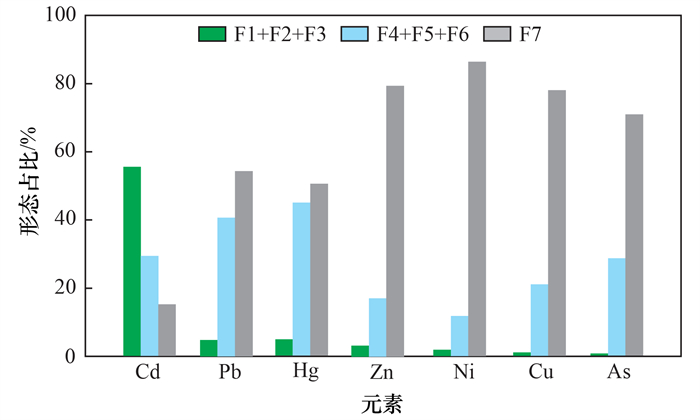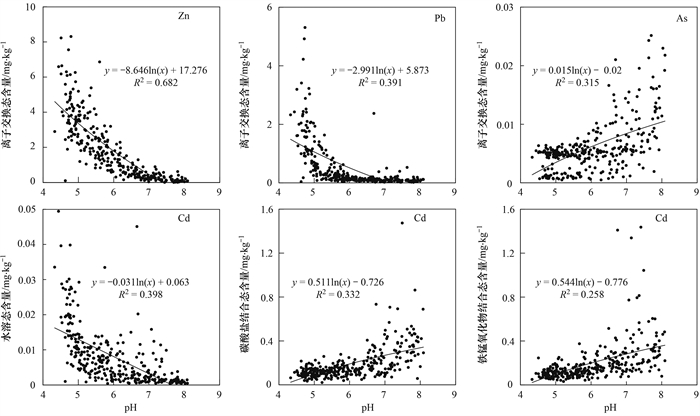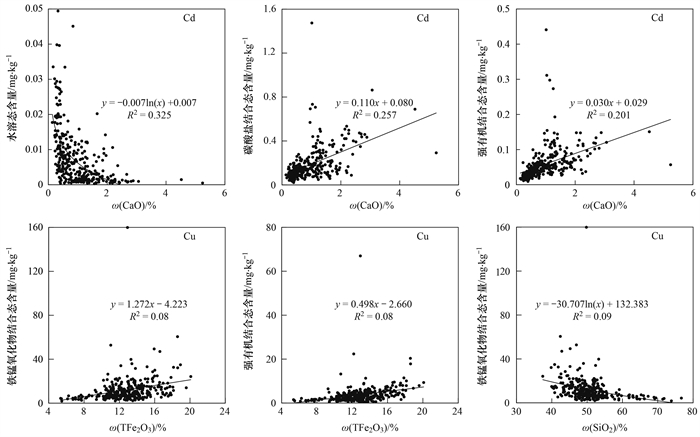2. 山东省物化探勘查院, 济南 250013;
3. 山东省地质测绘院, 济南 250014
2. Shandong Institute of Geophysical and Geochemical Exploration, Jinan 250013, China;
3. ShandongGeo-Surveying and Mapping Institute, Jinan 250014, China
工业扩张、农业活动和矿山开采等人类活动引起的土壤污染和粮食安全日益引起决策部门和科研机构的重视[1~3]. 有研究表明, 土壤中过量重金属积累往往威胁人类健康, 引发诸如发育受损、智力下降、短期健忘症、认知障碍和心血管疾病等风险[4, 5]. 目前全球有超过1 000万个污染场地, 占地20万km2, 其中50%以上的土地是由重金属污染引起的[6, 7]. 中国耕地也面临重金属污染的严峻考验, 在国家层面先后实施了全国土地质量地球化学调查和国家土壤污染详查[8~12], 结果发现, 中国每年新增重金属污染的耕地约有1 000万hm2[13, 14], 耕地中度污染以上的点位比例为2.5%, 覆盖面积约2.3万km2[15].
上述国家尺度的土壤调查都是基于土壤重金属全量, 尽管土壤重金属的全量可以有效提供污染水平信息, 以确定阈值, 制定适当的政策, 然而, 土壤是由矿物、有机物、微生物和其他固体成分组成的复杂生态系统, 其数量、组成和表面特征深刻影响着重金属的迁移转化[16, 17]. 更为重要的是土壤重金属化学形态才是决定重金属生物活性和生物毒性的重要因素, 等量重金属由于化学形态的不同表现出的环境生物效应差异很大[18, 19]. 目前国家尺度的调查在土壤污染防控和土地资源精准管理方面做出了巨大贡献, 但是评价方法多以重金属全量为基础的经验评价[8~12], 如内梅罗指数法、地累积指数法和潜在污染指数法等[20, 21], 也有学者用《土壤环境质量农用地土壤污染风险管控标准》规定的筛选值和管控值来评价生态风险[22, 23], 以上方法忽视了我国幅员辽阔, 气候条件、地质背景和景观地貌区域性差别较大的问题. 如我国西南地区, 重金属多是由碳酸盐岩风化以及次生矿物形成[24, 25], 重金属含量很高, 但是其生物活性很低[26~29], 采用总量很难科学评价土壤重金属污染水平. 因此, 重金属化学形态成为污染评价和风险预测的重要依据. 长期以来, 围绕土壤酸碱度、有机质(OM)和土壤质地等理化指标对重金属化学形态的影响开展了大量工作, 研究表明土壤重金属总量与其化学形态和生物效应间有密切的关系[30~32], 但多数研究仅停留在定性描述, 缺乏影响因素的定量研究, 且普遍存在样本量不足, 代表性不够的问题.
贵州省是我国重要的碳酸盐岩分布区, 是特殊的重金属高地质背景区[33], 重金属大多为地质成因, 生物有效性较低[34], 按照中国现行的土壤环境质量标准, 大部分耕地必须休耕或改变土地用途, 这将产生较大的社会影响和资源浪费. 本研究选择贵州省赫章县典型碳酸盐岩分布区农田表层土壤为研究对象, 分析了土壤中7种重金属化学形态, 旨在:①研究高地质背景区土壤重金属化学形态空间分布规律;②探索影响土壤重金属形态分布的因素;③建立高地质背景区土壤重金属生物有效组分含量回归模型, 定量描述主要影响因素的贡献.
1 材料与方法 1.1 研究区概况研究区位于贵州省毕节市赫章县, 北纬26°46′12″~ 27°28'18″, 东经104°10′28″~105°01'23″, 森林覆盖率高达59.03%, 地形以山地为主, 碳酸盐岩分布广, 属典型的喀斯特岩溶区. 气候属暖温带气候, 年均气温在10~13.6℃之间, 年均降雨量介于786~1 068 mm, 雨量充沛, 光照条件较好, 太阳辐射强度较高, 季节变化不明显. 全国土地调查结果显示土地利用类型以耕地和林地为主. 研究区(图 1)出露地层以碳酸盐岩、峨眉山玄武岩和砂岩为主, 309件土壤表层样品全部采自农田, 以较高的密度覆盖整个研究区和不同成土母质区.

|
图 1 研究区采样点位及地质示意 Fig. 1 Sampling sites and geological map in study area |
样品采集严格按照土地质量地球化学调查要求, 采样点全部位于农田, 采用梅花形布点法从5个点取等质量土壤混合组成1件分析样品, 采样深度为0~20 cm, 土壤样品去除石粒、杂草和动植物残体等非土壤成分, 选择通风、整洁和无污染的场地自然风干, 用橡皮锤敲打, 全部过20目尼龙筛, 均匀混合后四分法取样, 装入乙烯样品瓶后送实验室分析.
本次测试指标为表层土壤中8种重金属(As、Cd、Cr、Cu、Hg、Ni、Pb和Zn)的全量, 采用“七步提取法”定量分析了除Cr之外7种重金属的不同化学形态. 同时还分析了pH、Na2O、SiO2、Al2O3、TFe2O3、CaO、K2O、MgO、OM和Mn的含量. 所有样品严格按照《生态地球化学评价样品分析技术要求(试行)》(DD 2005-03)规范的方法测试, 表层土壤样品(全量)选用12种国家一级标准物质用选定分析方法进行12次分析检验, pH值测定采用6种国家一级标准物质进行分析, 重金属形态样品选用4种国家一级标准物质选定分析方法对每一个标准物质进行8次分析检验, 分别统计各被测项目平均值与标准值之间的对数差(ΔlgC)和相对标准偏差(RSD%), 合格率为100%. 湖北省地质实验测试中心完成了本次分析测试, 抽取土壤外检样品122件, 形态外检样品51件送南京矿产资源监督检测中心进行分析评价, 合格率分别为100%和92.86%. 各指标的分析方法、检出限、准确度和精密度均符合有关规范要求并通过了中国地质调查局质量监控中心验收, 结果真实可靠.
1.3 数据统计分析点位设计及其成果图件利用ArcGIS 10.2完成, 地球化学统计参数, 如最大值、最小值、中位值、平均值、标准偏差和变异系数等利用Excel 2020完成, 斯皮尔曼(Spearman)相关系数和回归模型使用SPSS 22.0(IBM, USA)软件完成. 所有图件最后均通过CorelDRAW X8进行图形矢量处理.
1.4 土壤重金属形态生态风险评价等级风险评价编码法(RAC)是根据元素生物有效性含量占全量的百分比来评估环境风险[35]. 本文形态测量采用改进的Tessier七步顺序提取法, 获取了重金属水溶态(F1)、离子交换态(F2)、碳酸盐结合态(F3)、弱有机结合态(F4)、铁锰氧化物结合态(F5)、强有机结合态(F6)和残渣态(F7)这7种化学形态. 其中F1、F2和F3易被植物吸收, 活性较大, 划分为生物有效组分;F4、F5和F6在一定环境下易被植物吸收, 划分为潜在生物有效组分;F7比较稳定, 不易被植物吸收[18, 36], 为残渣态. RAC的计算方法见下式.

|
(1) |
式中, ω为元素全量(mg·kg-1), RAC值越高, 生物有效性越高, 环境风险越大, RAC值越低, 生物有效性越低, 环境风险越小. 根据RAC值大小, 生态风险划分为:极高风险(> 50%)、高风险(30%~50%)、中等风险(10%~30%)、低风险(1%~10%)和无风险(< 1%).
2 结果与分析 2.1 表层土壤元素含量特征研究区各元素的含量特征示于表 1, 研究区表层土壤中主量元素ω(K2O)、ω(Na2O)、ω(SiO2)和ω(CaO)的平均值分别为1.45%、0.55%、50.54%和0.98%, 分别是中国土壤背景值的0.65、0.39、0.78和0.45倍, 为显著亏损;表层土壤中Al2O₃、TFe2O3和MgO含量是中国土壤背景值的1.33、3.06和1.48倍, 为相对富集;土壤OM平均含量为2.65%, 是中国土壤背景值的1.47倍;研究区土壤pH值在4.33~8.09之间, 平均值为6.04, 多数为酸性土壤.
|
|
表 1 研究区土壤表层元素含量地球化学统计参数1) Table 1 Geochemical statisticas of element concentrations in topsoil samples |
研究区表层土壤中8种重金属元素ω(As)、ω(Cd)、ω(Cr)、ω(Cu)、ω(Hg)、ω(Ni)、ω(Pb)和ω(Zn)的平均值分别为8.79、1.34、219.11、123.99、0.13、80.02、32.19和173.30 mg·kg-1, 分别是全国土壤背景值的0.78、13.37、3.59、5.49、1.92、2.97、1.24和2.34倍. 除As之外, 其余重金属元素均为显著富集, 特别是Cd和Cr, 超过全国土壤背景值的5倍以上. Cd、Cr、Cu和Hg的变异系数分别为69%、46%、51%和51%, 按照相关变异系数划分标准, 为高度变异, 指示受人为或外来活动影响.
上述元素含量特征是两个原因引起的, 一是受水热条件和碳酸盐岩风化和成土过程的影响, 可溶性离子Ca2+、Mg2+、Na+和K+等从母岩中浸出淋失和难溶或不溶物质如Cd、Zn、Cr、As、Fe和Al原地残留或被铁锰氧化物吸收富集, 反映了地质背景和气候条件对土壤中元素含量的影响;二是本研究采样点在农田, 是人为扰动和自然环境交互影响的复杂农田系统, 受耕种过程中肥料、农药和农业用品使用的影响, Cd、Cr和Cu等农业活动标志性元素含量升高, 在土壤中高度富集, 反映了农业活动对土壤中元素含量的影响.
2.2 表层土壤重金属元素形态含量分布特征重金属化学形态是影响重金属在农田系统中迁移转化的重要因素, 研究重金属的形态可以更好地研究其环境地球化学行为和生物利用度[18]. 土壤重金属元素(As、Cd、Cu、Hg、Ni、Pb和Zn)形态分布如表 2所示. 结果表明, 土壤中重金属As(70.77%)、Cu(77.97%)、Hg(50.38%)、Ni(86.34%)、Pb(54.41%)和Zn(79.51%)多以残渣态存在, 表明这些元素以原生矿物和次级硅酸盐矿物的形式在晶格中结合[40], 其化学性质比较稳定, 不可能对生态系统产生影响[41]. 除残渣态之外, Pb和Hg的潜在生物有效组分含量也较高, 这与沉积物中的铁锰氧化物含量有关, Mn-Fe氢氧化物是金属的主要吸附剂[42]. 部分重金属含量也与OM含量有关, 与土壤中腐殖质物质具有很强的亲和力[43].
|
|
表 2 土壤重金属各组分化学形态比例/% Table 2 Percentage of different chemical speciation of heavy metals/% |
生物有效组分(F1+F2+F3)被认为是评估生物利用度和环境风险的重要因素[44]. 土壤中各元素的生物有效组分顺序如图 2:Cd(55.49%) > Pb(4.88%) > Hg(4.76%) > Zn(3.28%) > Ni(1.85%) > Cu(1.01%) > As(0.67%). 研究区除Cd外其他重金属生物活性均较低, 迁移能力较差. Cd的残渣态含量较低, 仅为15.14%, 有效组分和潜在生物有效组分分别为55.49%和29.37%, 远远高于其他重金属, 这与Cd元素地球化学性质和矿业活动有关[34]. 本研究结果表明, 除Cd以外, 尽管Cr、Cu、Hg、Ni、Pb和Zn均超过全国土壤背景值, 含量较高, 但是有效组分均小于5%, 难以被农作物吸收, 生态风险较低. 因此, 基于重金属全量作为生态风险评价的标准远高于实际风险.

|
图 2 土壤重金属化学形态分布特征 Fig. 2 Chemical speciation of heavy metals in the soil samples |
土壤中7种重金属元素的RAC如表 3所示, 表层土壤As、Cu和Ni有效态比例较低, 供植物直接吸收利用的部分较少, 仅存在低生态风险等级以下的土地;Hg、Pb和Zn仅存在中等生态风险等级以下的土地, 占比分别为10.68%、7.44%和0.65%, 比例较低, 无高风险和极高风险的土地. 研究区有土法炼锌的历史, 禁止几十年后, Pb和Zn的影响已经较低, 对农田影响较小, 保持现状, 定期监测即可;Cd是风险最高的元素, 其中极高风险、高风险和中等风险的比例分别为65.37%、33.33%和0.97%, 需要开展风险区土壤Cd来源以及农作物安全专项研究, 加强这部分土地的监管(图 3).
|
|
表 3 表层土壤重金属元素生态风险等级分布1) Table 3 Class distribution of ecological riskfor heavy metals in top soil |

|
图 3 土壤重金属形态综合生态风险空间分布 Fig. 3 Spatial distribution of potential ecological risks of heavy metal chemical speciation |
土壤是一个复杂的生态系统, 土壤重金属的形态是一个动态变化的过程, 不仅受元素本身的地球化学性质的影响, 还与土壤理化性质和根际环境关系密切[18, 22, 45]. 本研究采用Spearman相关分析, 研究了土壤pH、OM、氧化物(SiO2、Al2O3、TFe2O3、MgO、CaO)和土壤全量与7种重金属不同化学形态的关系, 相关分析结果如表 4所示.
|
|
表 4 土壤重金属各形态与元素含量及理化指标相关分析1) Table 4 Correlations for chemical speciation, elements contents, and physicochemical properties |
3.1.1 土壤重金属全量对化学形态的影响
土壤中重金属各形态的含量与全量两者之间有显著的正相关关系, 自然成因的重金属主要赋存在残渣态等相对稳定的相态中, 人为成因的重金属主要赋存在活性较大, 易发生迁移的有效相态中[22]. 根据Spearman分析结果, 研究区土壤残渣态含量与全量呈明显的相关关系(表 4), 相关系数(R2值)范围为0.699~0.981, 除Cd以外, 相关系数均超过0.834, 为显著相关(图 4). 研究区Ni的水溶态(F1)与总量之间有显著相关关系, 其余重金属水溶态(F1)与总量之间无明显的相关关系. Cu和Cd、Ni和As的离子交换态(F2)与全量具有正相关关系, Cu和Cd的离子交换态(F2)与全量相关系数均大于0.5, 呈显著正相关(表 4). 水溶态(F1)和离子交换态(F2)具有较强的生物有效性, 说明研究区Cu、Cd、Ni和As这4种重金属的全量对生物有效性有较强的影响.

|
图 4 土壤重金属残渣态与全量含量关系散点图 Fig. 4 Scatter plot of residual form and total contents of heavy metals in soil |
Spearman相关分析结果显示, 研究区pH值与Pb和Zn的离子交换态(F2)具有显著负相关关系, 与As的离子交换态(F2)和碳酸盐结合态(F3)具有显著正相关关系. pH值与Cd的各种形态关系都比较紧密, 与Cd的水溶态(F1)和离子交换态(F2)具有显著负相关, 与其它形态显著正相关(图 5). 说明在酸性条件下, Pb、Zn和Cd生物活性较强, 碱性条件下, 重金属生物活性较低. OM对重金属的形态分布影响较小, 与Pb弱有机结合态(F4)和铁锰氧化物结合态(F5)具有显著正相关关系, 与Zn、Cd、As和Hg弱有机结合态(F4)具有显著正相关关系, 与Pb和Hg残渣态(F7)具有显著正相关关系, 与其它重金属各形态均无较强的相关关系.

|
图 5 土壤重金属化学形态与pH值关系散点图 Fig. 5 Scatter plot of chemical speciation of heavy metals and pH value in soil |
氧化物一般是影响土壤中重金属存在形态的关键因素之一[45, 46]. 研究区土壤中TFe2O3含量与Cu强有机结合态(F6)和残渣态(F7)有显著相关关系, 与其它重金属各形态均无较强的相关关系(图 6);土壤中CaO与Cd的化学形态较为密切, 与水溶态(F1)具有显著负相关, 与碳酸盐结合态(F3)和强有机结合态(F6)具有显著正相关(图 6). SiO2与Cu强有机结合态(F6)和残渣态(F7)具有显著负相关关系;Al2O3与As水溶态(F1)具有显著负相关;MgO与Pb的潜在生物有效组分和残渣态(F7)具有显著负相关关系, 与Ni潜在生物有效组分和残渣态(F7)具有显著正相关关系. 研究区氧化物含量对各重金属形态的影响较为复杂, 与长期该地土法炼锌的活动有关.

|
图 6 土壤重金属化学形态与氧化物含量关系散点图 Fig. 6 Scatter plot of chemical speciation and oxide contents of heavy metals in soil |
土壤重金属化学形态受多种因素的影响和控制, 如重金属之间的拮抗、协同作用以及上述讨论中的土壤理化指标和土壤氧化物含量等, 这些因素之间存在多重共线性关系. 因此, 本研究采用逐步回归(stepwise regression)分析方法, 将土壤重金属全量、土壤氧化物含量、pH值和OM含量等指标作为重金属生物有效组分含量的自变量, 建立了最优回归模型, Cd、Cu、Pb、Zn、Ni和As的回归方程如表 5所示, 逐步法无法建立Hg生物有效组分的回归方程, 这是由于自变量与形成的预测方程有较大的共线性, 变量的显著性未达到要求, 采用进入法进行回归分析, P值(显著性)为0.184, 也未达到显著性要求, 故所列自变量对Hg生物有效组分含量影响较小.
|
|
表 5 土壤重金属生物有效组分回归模型及主要影响因素1) Table 5 Soil heavy metal bioavailable component regression model and influencing factors |
Cd生物有效组分含量预测方程预测精度较高, R2值为0.867, P < 0.01, 自变量贡献降序排列为:Cd > pH > OM > Al2O3 > K2O, 其中主要影响变量为Cd和pH值, 相对贡献率分别为60.90%和17.04%. Pb生物有效组分含量预测方程预测精度为可接受水平, R2值为0.650, P < 0.01, 自变量贡献降序排列:pH > Pb > MgO > TFe2O3, 其中主要影响变量为pH、Pb和MgO, 相对贡献率分别36.85%、21.35%和20.08%. Cu生物有效组分含量预测方程R2值为0.564, P < 0.01, 自变量贡献降序排列:Cu > TFe2O3 > K2O > pH, 其中主要影响变量为Cu和TFe2O3, 相对贡献率分别57.38%和26.24%. Zn生物有效组分含量预测方程R2值为0.471, P < 0.01, 自变量贡献降序排列:pH > OM > K2O > MgO > Zn, 其中主要影响变量为pH和OM, 相对贡献率分别30.02%和20.44%. Ni生物有效组分含量预测方程R2值为0.400, P < 0.01, 自变量贡献降序排列:Ni > pH > K2O > MgO, 其中主要影响变量为Ni和pH, 相对贡献率分别35.41%和30.30%. As生物有效组分含量预测方程R2值为0.342, 精度较低.
4 结论(1)本研究清晰地说明了重金属化学形态是碳酸盐岩分布区农田生态风险评价的重要因素, 基于重金属生物有效组分含量的生态风险远小于基于土壤总量的生态风险, 土壤重金属生物有效组分可以更精确地表征重金属的生物活性和生物毒性, 更好地服务于政府部门国土规划.
(2)本研究阐明了重金属全量是土壤重金属化学形态的决定因素, 具有显著的正相关关系, 其次pH值和氧化物含量也是影响重金属化学形态主要因素. 但本研究缺乏土壤矿物组成、根际环境和大气环境等可能影响土壤重金属有效组分的环境因素指标, 今后随着研究深入, 将会提供农田系统元素迁移规律的成果.
(3)本研究建立的土壤重金属有效组分含量回归方程解决了多种影响因素之间存在多重共线性关系的问题, 预测精度较高, 为当前土壤金属元素有效态提取方法众多, 提取效果参差不齐, 分析成本较高等问题提供了较好的解决方案.
(4)本研究为高地质背景区生态风险评价提供了新方法, 研究结果表明仅以农田土壤重金属全量评价土地质量状况, 往往夸大了生态风险. 基于土壤重金属化学形态的生态风险评价为污染土壤修复治理提供了新思路.
| [1] | Hu Y N, He K L, Sun Z H, et al. Quantitative source apportionment of heavy metal(loid)s in the agricultural soils of an industrializing region and associated model uncertainty[J]. Journal of Hazardous Materials, 2020, 391. DOI:10.1016/j.jhazmat.2020.122244 |
| [2] | Ma L, Xiao T F, Ning Z P, et al. Pollution and health risk assessment of toxic metal(loid)s in soils under different land use in sulphide mineralized areas[J]. Science of the Total Environment, 2020, 724. DOI:10.1016/j.scitotenv.2020.138176 |
| [3] | Kelepertzis E, Argyraki A, Chrastn V, et al. Metal(loid) and isotopic tracing of Pb in soils, road and house dusts from the industrial area of Volos (central Greece)[J]. Science of the Total Environment, 2020, 725. DOI:10.1016/j.scitotenv.2020.138300 |
| [4] | Jiang H H, Cai L M, Wen H H, et al. An integrated approach to quantifying ecological and human health risks from different sources of soil heavy metals[J]. Science of the Total Environment, 2020, 701. DOI:10.1016/j.scitotenv.2019.134466 |
| [5] | Cheng W, Lei S G, Bian Z F, et al. Geographic distribution of heavy metals and identification of their sources in soils near large, open-pit coal mines using positive matrix factorization[J]. Journal of Hazardous Materials, 2020, 387. DOI:10.1016/j.jhazmat.2019.121666 |
| [6] | Khalid S, Shahid M, Niazi N K, et al. A comparison of technologies for remediation of heavy metal contaminated soils[J]. Journal of Geochemical Exploration, 2016, 182: 247-268. |
| [7] | Kumar S, Prasad S, Yadav K K, et al. Hazardous heavy metals contamination of vegetables and food chain: Role of sustainable remediation approaches - A review[J]. Environmental Research, 2019, 179. DOI:10.1016/j.envres.2019.108792 |
| [8] | Li M, Xi X H, Xiao G Y, et al. National multi-purpose regional geochemical survey in China[J]. Journal of Geochemical Exploration, 2014, 139: 21-30. DOI:10.1016/j.gexplo.2013.06.002 |
| [9] | Cheng H X, Li M, Xie X J, et al. Exploring China: environment and resources[J]. Journal of Geochemical Exploration, 2014, 139: 1-3. DOI:10.1016/j.gexplo.2014.02.003 |
| [10] | Yang Z F, Yu T, Hou Q Y, et al. Geochemical evaluation of land quality in China and its applications[J]. Journal of Geochemical Exploration, 2014, 139: 122-135. DOI:10.1016/j.gexplo.2013.07.014 |
| [11] |
李括, 彭敏, 赵传冬, 等. 全国土地质量地球化学调查二十年[J]. 地学前缘, 2019, 26(6): 128-158. Li K, Peng M, Zhao C D, et al. Vicennial implementation of geochemical survey of land quality in China[J]. Earth Science Frontiers, 2019, 26(6): 128-158. |
| [12] | Teng Y G, Wu J, Lu S J, et al. Soil and soil environmental quality monitoring in China: a review[J]. Environment International, 2014, 69: 177-199. DOI:10.1016/j.envint.2014.04.014 |
| [13] | Chen H M, Zheng C R, Tu C, et al. Heavy metal pollution in soils in China: status and countermeasures[J]. AMBIO - A Journal of the Human Environment, 1999, 28(2): 130-134. |
| [14] | Dong W Q Y, Cui Y, Liu X. Instances of soil and crop heavy metal contamination in China[J]. Soil and Sediment Contamination: An International Journal, 2001, 10(5): 497-510. DOI:10.1080/20015891109392 |
| [15] | 中国地质调查局. 中国耕地地球化学调查报告(2015年)[EB/OL]. http://zrzy.jiangsu.gov.cn/upfile/File/201512/10/10431190.pdf, 2015-06-25. |
| [16] | Fariña A O, Peacock C L, Fiol S, et al. A universal adsorption behaviour for Cu uptake by iron (hydr)oxide organo-mineral composites[J]. Chemical Geology, 2018, 479: 22-35. DOI:10.1016/j.chemgeo.2017.12.022 |
| [17] | Qin C C, Yuan X Z, Xiong T, et al. Physicochemical properties, metal availability and bacterial community structure in heavy metal-polluted soil remediated by montmorillonite-based amendments[J]. Chemosphere, 2020, 261. DOI:10.1016/j.chemosphere.2020.128010 |
| [18] |
周国华. 土壤重金属生物有效性研究进展[J]. 物探与化探, 2014, 38(6): 1097-1106. Zhou G H. Recent progress in the study of heavy metal bioavailability in soil[J]. Geophysical and Geochemical Exploration, 2014, 38(6): 1097-1106. |
| [19] |
马宏宏, 彭敏, 刘飞, 等. 广西典型碳酸盐岩区农田土壤-作物系统重金属生物有效性及迁移富集特征[J]. 环境科学, 2020, 41(1): 449-459. Ma H H, Peng M, Liu F, et al. Bioavailability, translocation, and accumulation characteristic of heavy metals in a soil - crop system from a typical carbonate rock Area in Guangxi, China[J]. Environmental Science, 2020, 41(1): 449-459. |
| [20] |
王依滴, 欧阳威, 刘连华, 等. 黄河干流沉积物重金属的赋存形态特征及污染评价[J]. 环境科学, 2023, 44(12): 6720-6727. Wang Y D, Ouyang W, Liu L H, et al. Fraction characteristic and risk assessment of heavy metals in surface sediments of the yellow river mainstream[J]. Environmental Science, 2023, 44(12): 6720-6727. |
| [21] |
马宏宏, 张利, 郭飞, 等. 贵州铅锌矿区土壤和作物重金属生态风险与迁移特征[J]. 环境科学, 2023, 44(5): 2856-2867. Ma H H, Zhang L, Guo F, et al. Ecological risk and migration patterns of heavy metals in soil and crops in the lead-zinc mining area in Guizhou, China[J]. Environmental Science, 2023, 44(5): 2856-2867. |
| [22] | Wen Y B, Li W, Yang Z F, et al. Evaluation of various approaches to predict cadmium bioavailability to rice grown in soils with high geochemical background in the karst region, southwestern China[J]. Environmental Pollution, 2020, 258. DOI:10.1016/j.envpol.2019.113645 |
| [23] | Xia X Q, Ji J F, Yang Z F, et al. Cadmium risk in the soil-plant system caused by weathering of carbonate bedrock[J]. Chemosphere, 2020, 254. DOI:10.1016/j.chemosphere.2020.126799 |
| [24] |
朱其清, 尹楚良, 唐丽华, 等. 石灰岩土中微量元素的含量与分布[J]. 土壤学报, 1984, 21(1): 58-69. Zhu Q Q, Yin C L, Tang L H, et al. Content and distribution of trace elements in limestone soils of China[J]. Acta Pedologica Sinica, 1984, 21(1): 58-69. |
| [25] |
周德全, 王世杰, 刘秀明. 石灰土(碳酸盐岩风化壳)形成地球化学过程研究[J]. 地球与环境, 2005, 33(2): 31-38. Zhou D Q, Wang S J, Liu X M. Study on geochemical processes in limestone soil profiles[J]. Earth and Environment, 2005, 33(2): 31-38. |
| [26] | Liu Y Z, Liu C S, Song C S, et al. Geochemical factors controlling the mobilization of geogenic cadmium in soils developed on carbonate bedrocks in Southwest China[J]. Geoderma, 2023, 437. DOI:10.1016/j.geoderma.2023.116606 |
| [27] |
韩伟, 王成文, 彭敏, 等. 川南山区土壤与农作物重金属特征及成因[J]. 环境科学, 2021, 42(5): 2480-2489. Han W, Wang C W, Peng M, et al. Characteristics and origins of heavy metals in soil and crops in mountain area of southern Sichuan[J]. Environmental Science, 2021, 42(5): 2480-2489. |
| [28] |
张富贵, 彭敏, 王惠艳, 等. 基于乡镇尺度的西南重金属高背景区土壤重金属生态风险评价[J]. 环境科学, 2020, 41(9): 4197-4209. Zhang F G, Peng M, Wang H Y, et al. Ecological risk assessment of heavy metals at township scale in the high background of heavy metals, Southwestern, China[J]. Environmental Science, 2020, 41(9): 4197-4209. |
| [29] |
周艳, 陈樯, 邓绍坡, 等. 西南某铅锌矿区农田土壤重金属空间主成分分析及生态风险评价[J]. 环境科学, 2018, 39(6): 2884-2892. Zhou Y, Chen Q, Deng S P, et al. Principal component analysis and ecological risk assessment of heavy metals in farmland soils around a Pb-Zn mine in southwestern China[J]. Environmental Science, 2018, 39(6): 2884-2892. |
| [30] | Wang S F, Jia Y F, Wang S Y, et al. Fractionation of heavy metals in shallow marine sediments from Jinzhou Bay, China[J]. Journal of Environmental Sciences, 2010, 22(1): 23-31. DOI:10.1016/S1001-0742(09)60070-X |
| [31] | Devi U, Bhattacharyya K G. Mobility and bioavailability of Cd, Co, Cr, Cu, Mn and Zn in surface runoff sediments in the urban catchment area of Guwahati, India[J]. Applied Water Science, 2018, 8(1). DOI:10.1007/s13201-018-0651-8 |
| [32] | Guo W, Huo S L, Xi B D, et al. Heavy metal contamination in sediments from typical lakes in the five geographic regions of China: distribution, bioavailability, and risk[J]. Ecological Engineering, 2015, 81: 243-255. DOI:10.1016/j.ecoleng.2015.04.047 |
| [33] |
杨琼, 杨忠芳, 张起钻, 等. 中国广西岩溶地质高背景区土壤-水稻系统Cd等重金属生态风险评价[J]. 中国科学: 地球科学, 2021, 64(8): 1317-1331. Yang Q, Yang Z F, Zhang Q Z, et al. Ecological risk assessment of Cd and other heavy metals in soil-rice system in the karst areas with high geochemical background of Guangxi, China[J]. Science China Earth Sciences, 2021, 64(7): 1126-1139. |
| [34] |
张富贵, 彭敏, 贺灵, 等. 贵州省典型铅锌矿区潜在有毒元素(PTEs)物源甄别、生态风险评价及控制因素[J]. 环境科学, 2022, 43(4): 2081-2093. Zhang F G, Peng M, He L, et al. Sources identification, ecological risk assessment, and controlling factors of potentially toxic elements in typical lead-zinc mine area, Guizhou province, southwest China[J]. Environmental Science, 2022, 43(4): 2081-2093. |
| [35] | Ke X, Gui S F, Huang H, et al. Ecological risk assessment and source identification for heavy metals in surface sediment from the Liaohe River protected area, China[J]. Chemosphere, 2017, 175: 473-481. DOI:10.1016/j.chemosphere.2017.02.029 |
| [36] | Zhang J R, Li H Z, Zhou Y Z, et al. Bioavailability and soil-to-crop transfer of heavy metals in farmland soils: A case study in the Pearl River Delta, South China[J]. Environmental Pollution, 2018, 235: 710-719. DOI:10.1016/j.envpol.2017.12.106 |
| [37] | 迟清华, 鄢明才. 应用地球化学元素丰度数据手册[M]. 北京: 地质出版社, 2007. |
| [38] |
何邵麟, 陈武, 刘应忠, 等. 贵阳市土壤地球化学背景与生态环境分析[J]. 地球与环境, 2015, 43(6): 642-652. He S L, Chen W, Liu Y Z, et al. Geochemical background and ecologic environment of soil in Guiyang city, Guizhou province, China[J]. Earth and Environment, 2015, 43(6): 642-652. |
| [39] | 中国土壤元素背景值[M]. 北京: 中国环境科学出版社, 1990. |
| [40] | Li M, Zang S Y, Xiao H F, et al. Speciation and distribution characteristics of heavy metals and pollution assessments in the sediments of Nashina Lake, Heilongjiang, China[J]. Ecotoxicology, 2014, 23(4): 681-688. DOI:10.1007/s10646-014-1180-3 |
| [41] | Zhang C, Shan B Q, Tang W Z, et al. Heavy metal concentrations and speciation in riverine sediments and the risks posed in three urban belts in the Haihe Basin[J]. Ecotoxicology and Environmental Safety, 2017, 139: 263-271. DOI:10.1016/j.ecoenv.2017.01.047 |
| [42] | Filgueiras A V, Lavilla I, Bendicho C. Chemical sequential extraction for metal partitioning in environmental solid samples[J]. Journal of Environmental Monitoring, 2002, 4(6): 823-857. DOI:10.1039/b207574c |
| [43] | Sundaray S K, Nayak B B, Lin S, et al. Geochemical speciation and risk assessment of heavy metals in the river estuarine sediments—A case study: Mahanadi basin, India[J]. Journal of Hazardous Materials, 2011, 186(2-3): 1837-1846. DOI:10.1016/j.jhazmat.2010.12.081 |
| [44] | Pérez-López R, Álvarez-Valero A M, Nieto J M, et al. Use of sequential extraction procedure for assessing the environmental impact at regional scale of the São Domingos Mine (Iberian Pyrite Belt)[J]. Applied Geochemistry, 2008, 23(12): 3452-3463. DOI:10.1016/j.apgeochem.2008.08.005 |
| [45] |
彭敏. 西南典型地质高背景区土壤-作物系统重金属迁移富集特征与控制因素[D]. 北京: 中国地质大学(北京), 2020. Peng M. Heavy metals in soil-crop system from typical high geological background areas, southwest China: transfer characteristics and controlling factors[D]. Beijing: China University of Geosciences (Beijing), 2020. |
| [46] | Wang J, Wang P M, Gu Y, et al. Iron–manganese (oxyhydro)oxides, rather than oxidation of sulfides, determine mobilization of cd during soil drainage in paddy soil systems[J]. Environmental Science & Technology, 2019, 53(5): 2500-2508. |
 2024, Vol. 45
2024, Vol. 45


